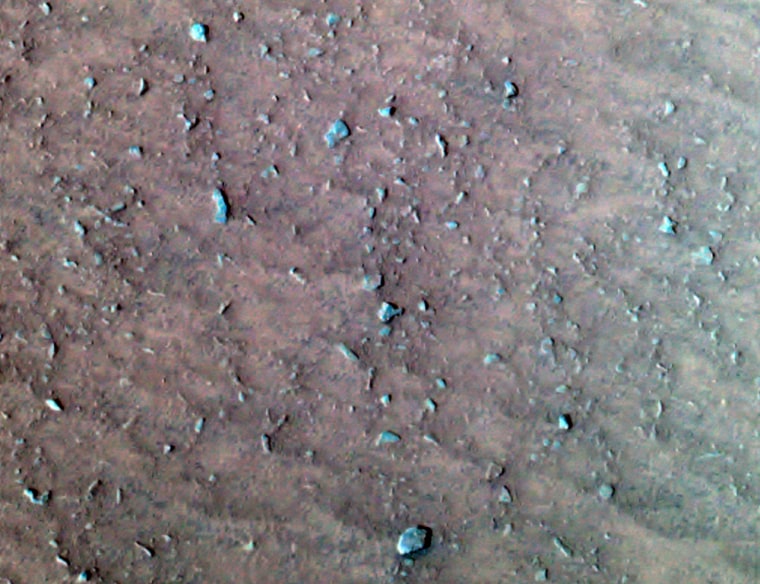NASA's Opportunity rover sent back new images from Mars showing that small spheres previously found on the surface also exist below, in a trench the rover dug. Hints of salty water were also found in the trench, but much more analysis is needed to learn the true composition.
Meanwhile Opportunity's twin rover, Spirit, is about to dig a trench of its own in order to investigate soil that sticks to its wheels, suggesting the fine-grained material might be moist.
Mission team members said at a press conference Thursday that the soil at both locations could contain small amounts of water mixed with salt in a brine that can exist in liquid form at very low temperatures.
The scientists stressed that only minuscule amounts of water would be needed to create the brine.
Water is the main thing scientists are searching for at Mars, because all life as we know it requires liquid water.
Rovers working 'spectacularly'
Mechanically speaking, both rovers are performing better than engineers promised and they might last into summer, well beyond the 90 days they were designed for, said Cornell University's Steven Squyres, principal investigator for the Mars Exploration Rover project.
Mission officials have long known that if all goes well, the rovers would indeed exceed the three-month life span that was considered a minimum design criteria. The robots face a host of threats, from frigid temperatures to high doses of radiation and wind-blown dust that can coat their solar panels, eliminating their source of power.
"These vehicles are holding up spectacularly," Squyres said at NASA's Jet Propulsion Laboratory in Pasadena, Calif. But he cautioned that "projections are very difficult to make." Still, he said all signs point to a lifetime "that could be considerably longer" than the original plan and that he hoped to be still doing rover science in the summer.
Opportunity's spheres
At Meridiani Planum near the equator of Mars, Opportunity has examined its self-dug trench. More data are yet to be returned, and that information should help scientists understand mysterious BB-sized spheres they've found strewn on the surface everywhere in the vicinity and embedded in a rock wall.

Now those spheres have been found in the trench.
Unlike those on the surface, the spheres in the wall of the trench are "polished and shiny," said geochemist Albert Yen of NASA’s Jet Propulsion Laboratory. No one knows why.
Yen said it's not surprising that the buried spheres are different from those at the surface, because they experience different conditions. Some coating could be responsible for the higher reflectivity of the long-buried spheres below. He said it was not due to just an effect of lighting.
In the broader sense, the spheres could have been formed in a volcano or by a meteor impact, or they might be the result of running water. Those are the three hypotheses researchers have been working with for several days now. Each is still a possibility.
Spirit's travels
On the other side of Mars, Spirit has begun to encounter rocks ejected from a modest impact crater toward which it is headed. The rocks could prove interesting as a way to study the interior of Mars, explained Dave Des Marais of NASA's Ames Research Center.
The destination, called Bonneville Crater, was carved out long ago by a space rock impact. Computer models show that rocks would have been carved from the crater in a reverse manner, the lower stuff being tossed higher and farther from the crater. Des Marais described it as similar to a flower opening.
"A lot of the older, deeper material gets thrown out farther," he said.
Spirit is starting to see rocks that could be those older ones. Finding out for sure will take weeks, in a two-pronged effort. Spirit will catalog the compositions and colors of several rocks along the way. When the rover reaches the crater, scientists hope to see some exposed layers in the crater wall, then match their colors up with the tossed-out rocks.
"This is a bit of a wish," Des Marais said, "but I think it's a real possibility."
About that soil ...
First, however, scientists want to study fine-grained soil that's sticking to Spirit's wheels. The rover will dig a trench to see whether the slightly cemented stuff exists below or is a surface phenomenon.
Des Marais said the material could be stuck together by a process in which water and salt collect at the surface and form a cement. The salt is drawn upward in a continual process. Then the water evaporates, leaving the salt behind. If that is what's going on, then there should be more salt at the surface than below.
The trench is not expected to become a well, however.
"I wouldn't expect to see a pool of water," he said.
